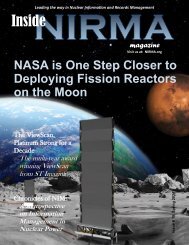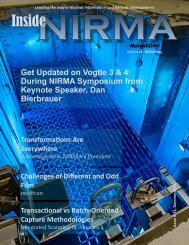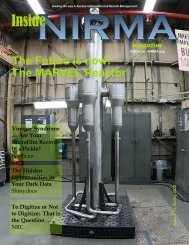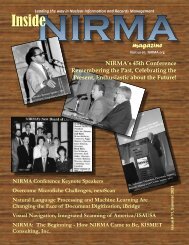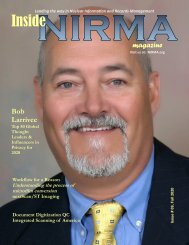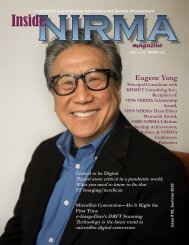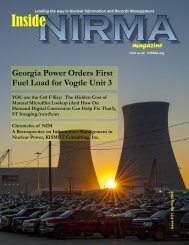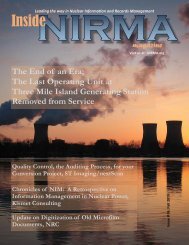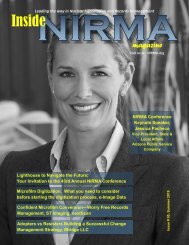Inside NIRMA Spring 2021
Create successful ePaper yourself
Turn your PDF publications into a flip-book with our unique Google optimized e-Paper software.
STimaging<br />
Continued from previous page.<br />
next can<br />
S<br />
the microfiche.<br />
confidence that<br />
each file was<br />
captured from<br />
assurance it is essential that the<br />
entire roll was captured into RAW<br />
data as it allows for quick and simple<br />
corrections to the archiving files.<br />
challenges when being converted to<br />
digital files. Rolls of microfilm sit on<br />
a spool which can be unrolled,<br />
scanned, and rewound in rather<br />
quick fashion. The transport<br />
regulates supply between intake and<br />
outtake spools. This job is<br />
performed by secure and stable<br />
motors that drive the spools of<br />
microfilm, a straight-forward<br />
procedure under a line scanner.<br />
To convert microfiche, the<br />
“transport” regulates the movement<br />
of the glass platen the fiche sits on.<br />
Using line scanning technology, a<br />
sheet of microfiche is loaded onto<br />
the transport. On a nextScan<br />
production scanner, the microfiche<br />
transport travels in a back-and-forth<br />
manner while moving up and down,<br />
like a typewriter. Though unlike the<br />
typewriter, production scanning<br />
technology is capable of scanning<br />
both forwards and backwards,<br />
creating more scans in less time.<br />
Once the capture process has<br />
taken place, proprietary software<br />
combs the data, and replicates the<br />
physical microfiche turning it into a<br />
digital ribbon. This allows the<br />
auditing process to occur, ensuring<br />
According to<br />
Manuel Bulwa,<br />
“All production level<br />
workflows hinge on<br />
automation and batch<br />
processing. Stop and<br />
go, transactional, ondemand<br />
processes and<br />
the like do not belong to<br />
the production realm.”<br />
Camera technology intended to<br />
capture a single image makes<br />
production microfiche scanning<br />
nearly impossible. Again, the<br />
microfiche must be on a transport<br />
and an additional step must take<br />
place, the fiche must come to a<br />
complete stop for a clear capture.<br />
There is no camera sensor that<br />
notifies the transport to stop, so the<br />
camera is essentially “capturing<br />
blind.” When this occurs, a scan may<br />
be split in two or missed entirely.<br />
These spliced and missed images<br />
must go through a costly rescanning<br />
process if they are even caught in the<br />
first place. If each image is not<br />
viewed by a person to verify the scan<br />
is a true conversion cannot be<br />
guaranteed.<br />
Production Scanning =<br />
True Conversion<br />
As previously stated, a<br />
production scanner captures all data<br />
on the reel of microfilm or sheet of<br />
microfiche, but how is the data<br />
captured, specifically? By using line<br />
scanning technology, the key<br />
determinant of a Production<br />
Scanner. The line scanning<br />
technology process allows for<br />
everything to be captured from the<br />
media, edge-to-edge and end-to-end,<br />
without a single pixel of information<br />
missed. Once captured, the software<br />
gets to work detecting edges and<br />
presenting an “Audit” or review of<br />
the captured images. A technician is<br />
then able to easily discern if any files<br />
or documents were missed, and<br />
instead of a rescan, simply revert that<br />
area to the RAW data and continue.<br />
To be confident of a complete<br />
conversion with real quality<br />
On-Demand microfilm<br />
scanners physically cannot capture<br />
film in the same way. The limitations<br />
of the CMOS image sensor force the<br />
scanner to move the film, stop,<br />
capture, and repeat. The CMOS also<br />
does not “know” what it is capturing<br />
allowing for images to be spliced if<br />
not directly in line with the image<br />
sensor. There is simply too much<br />
room for error when trying to<br />
conduct a conversion project using a<br />
scanner designed for On-Demand<br />
use.<br />
According to Manuel Bulwa,<br />
“All production level workflows<br />
hinge on automation and batch<br />
processing. Stop and go,<br />
transactional, on-demand processes<br />
and the like do not belong to the<br />
production realm.”<br />
Your Trusted Production<br />
Scanner<br />
There are fundamental and<br />
significant differences in a<br />
production scanner when compared<br />
to other types of microfilm scanners.<br />
nextScan defines a true production<br />
scanner as equipment designed for<br />
the simultaneous high-speed<br />
transportation and real-time capture<br />
of both microfilm and microfiche<br />
using line scanning technology,<br />
which provides a critical step that<br />
guarantees quality assurance by<br />
enabling users to complete an audit<br />
before finalizing the conversion.<br />
If you have questions on your<br />
current equipment or are looking for<br />
new equipment, please give us a call<br />
208-514-4000 or visit<br />
www.nextScan.com.<br />
8 <strong>Spring</strong> <strong>2021</strong> <strong>NIRMA</strong>.org <strong>Inside</strong> <strong>NIRMA</strong>



